Resource Dependency Theory In Supply Chain 2.
VerifiedAdded on 2022/08/15
|9
|1631
|43
AI Summary
Contribute Materials
Your contribution can guide someone’s learning journey. Share your
documents today.

Resource Dependency In Supply Chain 1
RESOURCE DEPENDENCY IN SUPPLY CHAIN
By (Name)
Course
Professor’s Name
Institution
Date
RESOURCE DEPENDENCY IN SUPPLY CHAIN
By (Name)
Course
Professor’s Name
Institution
Date
Secure Best Marks with AI Grader
Need help grading? Try our AI Grader for instant feedback on your assignments.
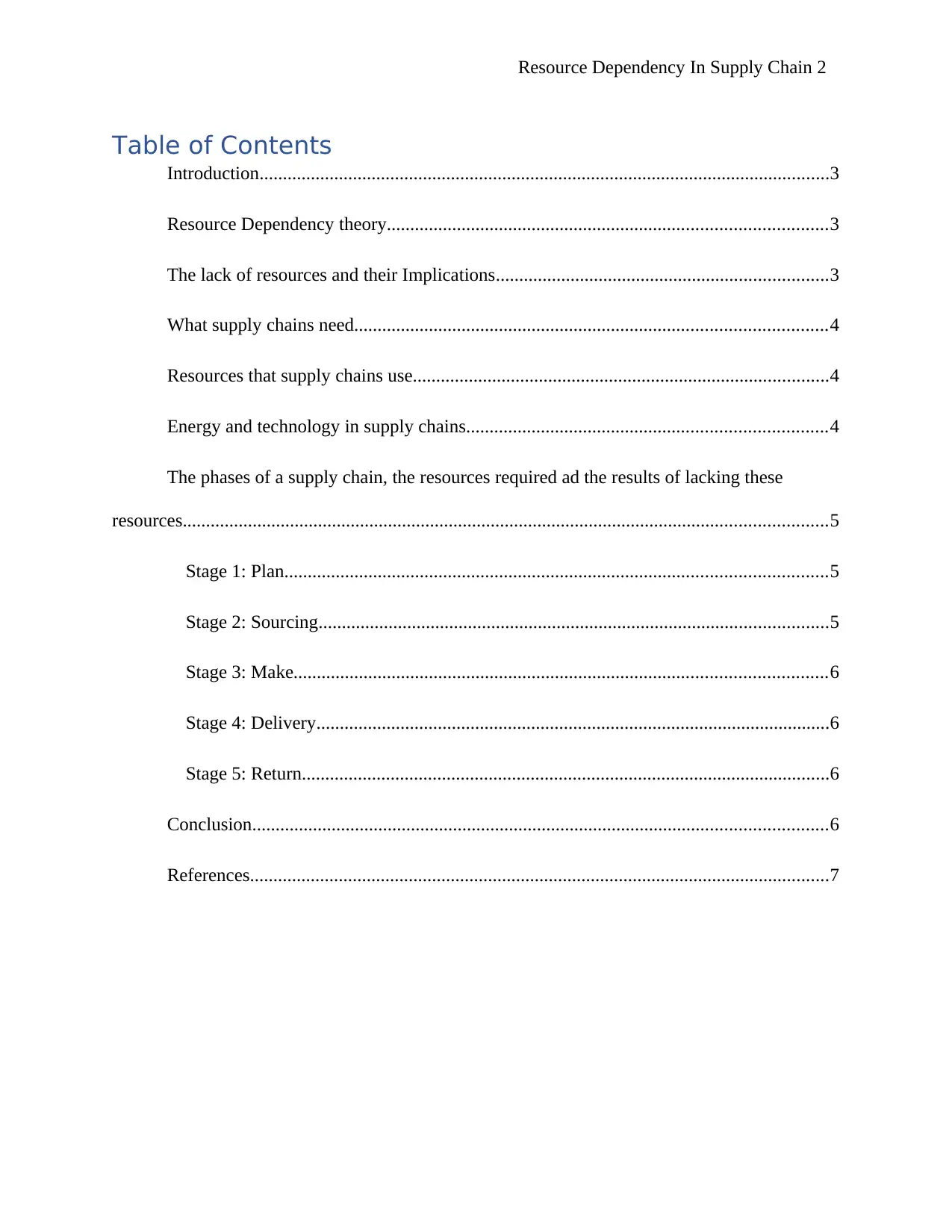
Resource Dependency In Supply Chain 2
Table of Contents
Introduction..........................................................................................................................3
Resource Dependency theory..............................................................................................3
The lack of resources and their Implications.......................................................................3
What supply chains need.....................................................................................................4
Resources that supply chains use.........................................................................................4
Energy and technology in supply chains.............................................................................4
The phases of a supply chain, the resources required ad the results of lacking these
resources..........................................................................................................................................5
Stage 1: Plan....................................................................................................................5
Stage 2: Sourcing.............................................................................................................5
Stage 3: Make..................................................................................................................6
Stage 4: Delivery..............................................................................................................6
Stage 5: Return.................................................................................................................6
Conclusion...........................................................................................................................6
References............................................................................................................................7
Table of Contents
Introduction..........................................................................................................................3
Resource Dependency theory..............................................................................................3
The lack of resources and their Implications.......................................................................3
What supply chains need.....................................................................................................4
Resources that supply chains use.........................................................................................4
Energy and technology in supply chains.............................................................................4
The phases of a supply chain, the resources required ad the results of lacking these
resources..........................................................................................................................................5
Stage 1: Plan....................................................................................................................5
Stage 2: Sourcing.............................................................................................................5
Stage 3: Make..................................................................................................................6
Stage 4: Delivery..............................................................................................................6
Stage 5: Return.................................................................................................................6
Conclusion...........................................................................................................................6
References............................................................................................................................7
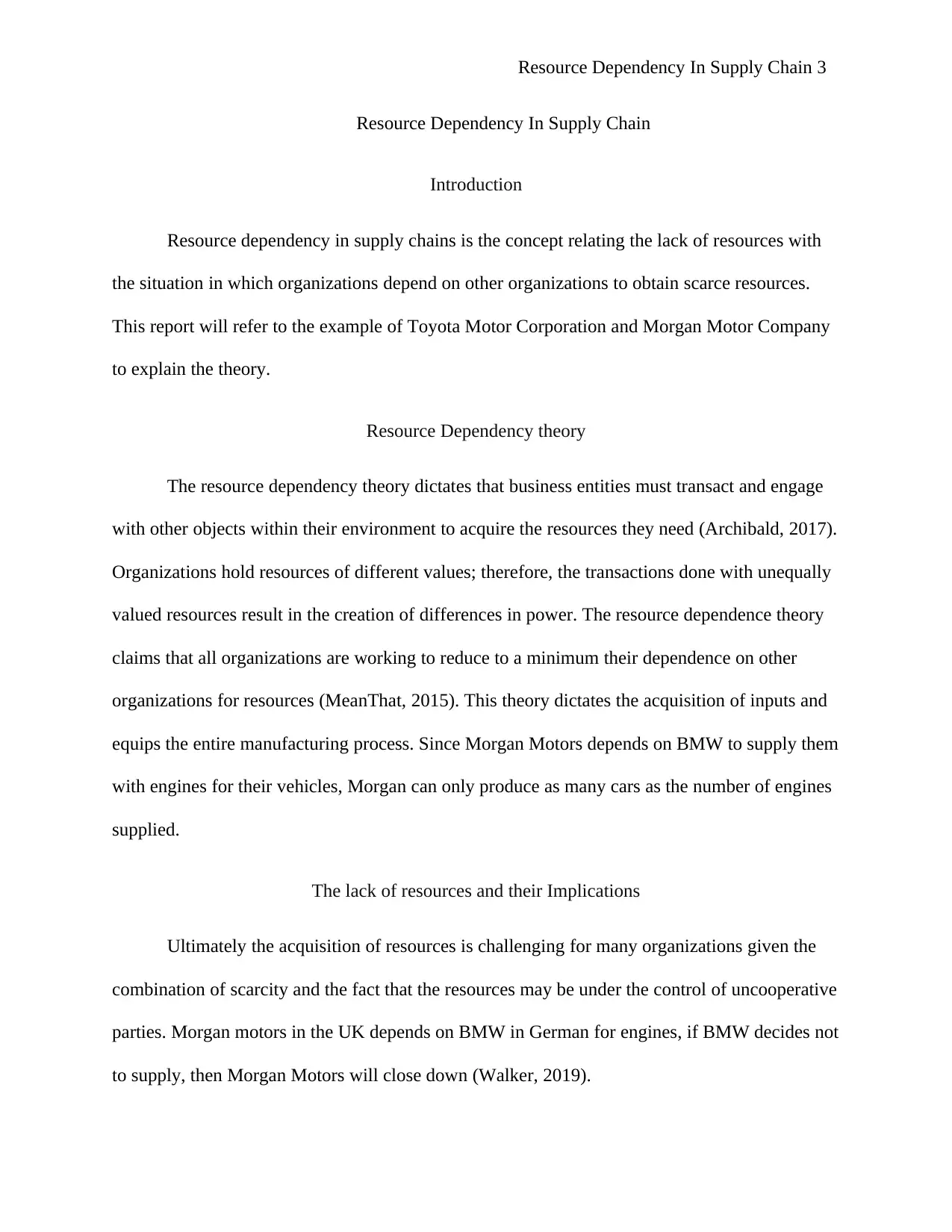
Resource Dependency In Supply Chain 3
Resource Dependency In Supply Chain
Introduction
Resource dependency in supply chains is the concept relating the lack of resources with
the situation in which organizations depend on other organizations to obtain scarce resources.
This report will refer to the example of Toyota Motor Corporation and Morgan Motor Company
to explain the theory.
Resource Dependency theory
The resource dependency theory dictates that business entities must transact and engage
with other objects within their environment to acquire the resources they need (Archibald, 2017).
Organizations hold resources of different values; therefore, the transactions done with unequally
valued resources result in the creation of differences in power. The resource dependence theory
claims that all organizations are working to reduce to a minimum their dependence on other
organizations for resources (MeanThat, 2015). This theory dictates the acquisition of inputs and
equips the entire manufacturing process. Since Morgan Motors depends on BMW to supply them
with engines for their vehicles, Morgan can only produce as many cars as the number of engines
supplied.
The lack of resources and their Implications
Ultimately the acquisition of resources is challenging for many organizations given the
combination of scarcity and the fact that the resources may be under the control of uncooperative
parties. Morgan motors in the UK depends on BMW in German for engines, if BMW decides not
to supply, then Morgan Motors will close down (Walker, 2019).
Resource Dependency In Supply Chain
Introduction
Resource dependency in supply chains is the concept relating the lack of resources with
the situation in which organizations depend on other organizations to obtain scarce resources.
This report will refer to the example of Toyota Motor Corporation and Morgan Motor Company
to explain the theory.
Resource Dependency theory
The resource dependency theory dictates that business entities must transact and engage
with other objects within their environment to acquire the resources they need (Archibald, 2017).
Organizations hold resources of different values; therefore, the transactions done with unequally
valued resources result in the creation of differences in power. The resource dependence theory
claims that all organizations are working to reduce to a minimum their dependence on other
organizations for resources (MeanThat, 2015). This theory dictates the acquisition of inputs and
equips the entire manufacturing process. Since Morgan Motors depends on BMW to supply them
with engines for their vehicles, Morgan can only produce as many cars as the number of engines
supplied.
The lack of resources and their Implications
Ultimately the acquisition of resources is challenging for many organizations given the
combination of scarcity and the fact that the resources may be under the control of uncooperative
parties. Morgan motors in the UK depends on BMW in German for engines, if BMW decides not
to supply, then Morgan Motors will close down (Walker, 2019).
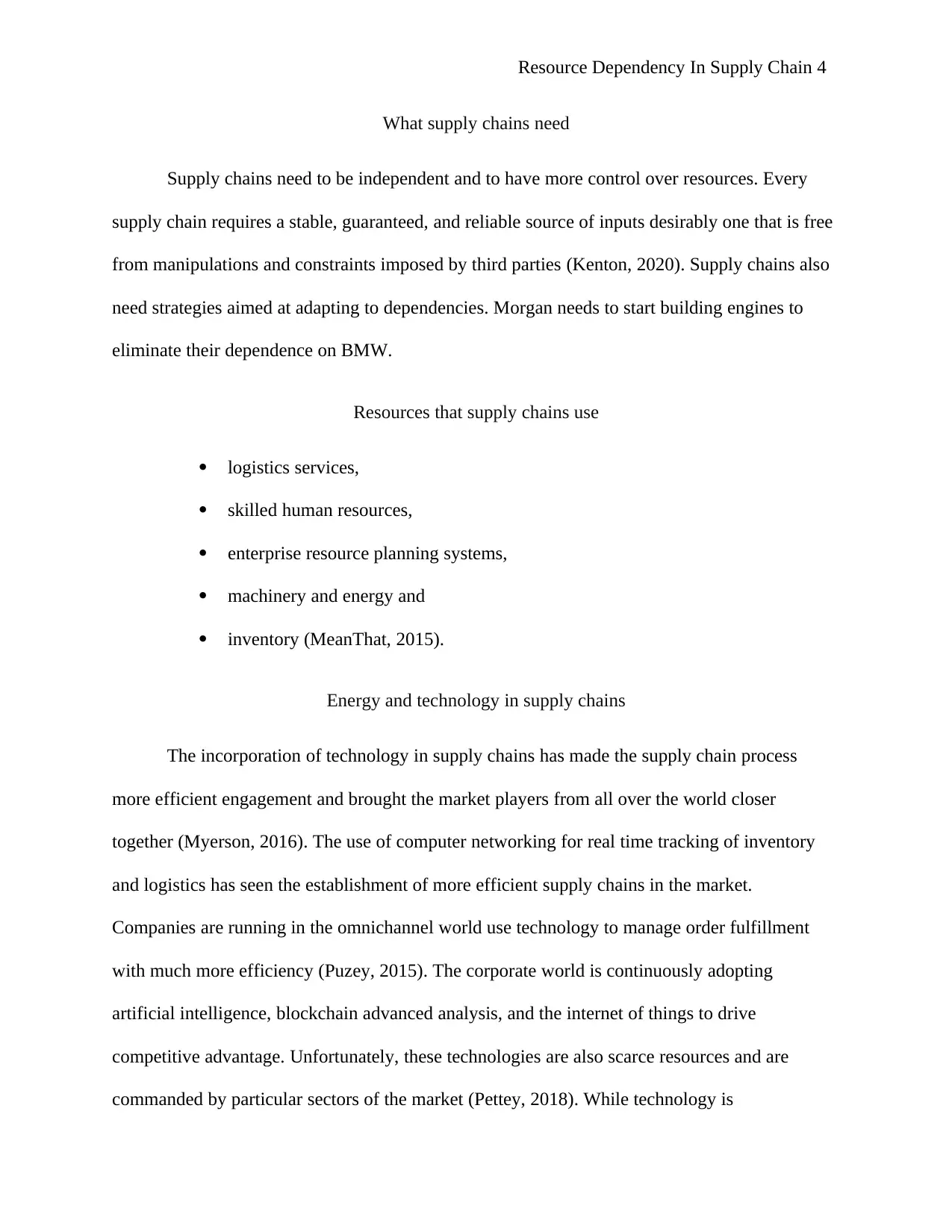
Resource Dependency In Supply Chain 4
What supply chains need
Supply chains need to be independent and to have more control over resources. Every
supply chain requires a stable, guaranteed, and reliable source of inputs desirably one that is free
from manipulations and constraints imposed by third parties (Kenton, 2020). Supply chains also
need strategies aimed at adapting to dependencies. Morgan needs to start building engines to
eliminate their dependence on BMW.
Resources that supply chains use
logistics services,
skilled human resources,
enterprise resource planning systems,
machinery and energy and
inventory (MeanThat, 2015).
Energy and technology in supply chains
The incorporation of technology in supply chains has made the supply chain process
more efficient engagement and brought the market players from all over the world closer
together (Myerson, 2016). The use of computer networking for real time tracking of inventory
and logistics has seen the establishment of more efficient supply chains in the market.
Companies are running in the omnichannel world use technology to manage order fulfillment
with much more efficiency (Puzey, 2015). The corporate world is continuously adopting
artificial intelligence, blockchain advanced analysis, and the internet of things to drive
competitive advantage. Unfortunately, these technologies are also scarce resources and are
commanded by particular sectors of the market (Pettey, 2018). While technology is
What supply chains need
Supply chains need to be independent and to have more control over resources. Every
supply chain requires a stable, guaranteed, and reliable source of inputs desirably one that is free
from manipulations and constraints imposed by third parties (Kenton, 2020). Supply chains also
need strategies aimed at adapting to dependencies. Morgan needs to start building engines to
eliminate their dependence on BMW.
Resources that supply chains use
logistics services,
skilled human resources,
enterprise resource planning systems,
machinery and energy and
inventory (MeanThat, 2015).
Energy and technology in supply chains
The incorporation of technology in supply chains has made the supply chain process
more efficient engagement and brought the market players from all over the world closer
together (Myerson, 2016). The use of computer networking for real time tracking of inventory
and logistics has seen the establishment of more efficient supply chains in the market.
Companies are running in the omnichannel world use technology to manage order fulfillment
with much more efficiency (Puzey, 2015). The corporate world is continuously adopting
artificial intelligence, blockchain advanced analysis, and the internet of things to drive
competitive advantage. Unfortunately, these technologies are also scarce resources and are
commanded by particular sectors of the market (Pettey, 2018). While technology is
Secure Best Marks with AI Grader
Need help grading? Try our AI Grader for instant feedback on your assignments.
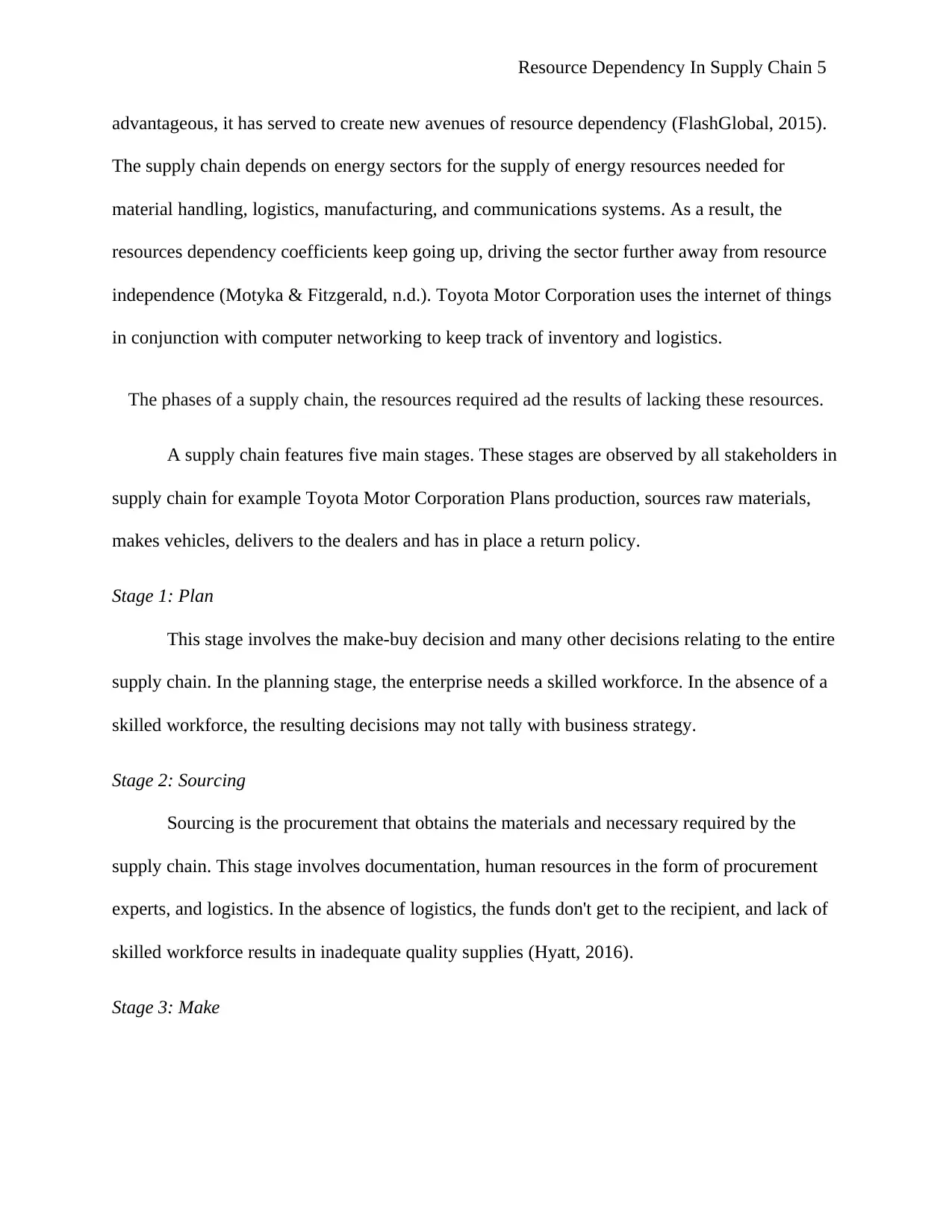
Resource Dependency In Supply Chain 5
advantageous, it has served to create new avenues of resource dependency (FlashGlobal, 2015).
The supply chain depends on energy sectors for the supply of energy resources needed for
material handling, logistics, manufacturing, and communications systems. As a result, the
resources dependency coefficients keep going up, driving the sector further away from resource
independence (Motyka & Fitzgerald, n.d.). Toyota Motor Corporation uses the internet of things
in conjunction with computer networking to keep track of inventory and logistics.
The phases of a supply chain, the resources required ad the results of lacking these resources.
A supply chain features five main stages. These stages are observed by all stakeholders in
supply chain for example Toyota Motor Corporation Plans production, sources raw materials,
makes vehicles, delivers to the dealers and has in place a return policy.
Stage 1: Plan
This stage involves the make-buy decision and many other decisions relating to the entire
supply chain. In the planning stage, the enterprise needs a skilled workforce. In the absence of a
skilled workforce, the resulting decisions may not tally with business strategy.
Stage 2: Sourcing
Sourcing is the procurement that obtains the materials and necessary required by the
supply chain. This stage involves documentation, human resources in the form of procurement
experts, and logistics. In the absence of logistics, the funds don't get to the recipient, and lack of
skilled workforce results in inadequate quality supplies (Hyatt, 2016).
Stage 3: Make
advantageous, it has served to create new avenues of resource dependency (FlashGlobal, 2015).
The supply chain depends on energy sectors for the supply of energy resources needed for
material handling, logistics, manufacturing, and communications systems. As a result, the
resources dependency coefficients keep going up, driving the sector further away from resource
independence (Motyka & Fitzgerald, n.d.). Toyota Motor Corporation uses the internet of things
in conjunction with computer networking to keep track of inventory and logistics.
The phases of a supply chain, the resources required ad the results of lacking these resources.
A supply chain features five main stages. These stages are observed by all stakeholders in
supply chain for example Toyota Motor Corporation Plans production, sources raw materials,
makes vehicles, delivers to the dealers and has in place a return policy.
Stage 1: Plan
This stage involves the make-buy decision and many other decisions relating to the entire
supply chain. In the planning stage, the enterprise needs a skilled workforce. In the absence of a
skilled workforce, the resulting decisions may not tally with business strategy.
Stage 2: Sourcing
Sourcing is the procurement that obtains the materials and necessary required by the
supply chain. This stage involves documentation, human resources in the form of procurement
experts, and logistics. In the absence of logistics, the funds don't get to the recipient, and lack of
skilled workforce results in inadequate quality supplies (Hyatt, 2016).
Stage 3: Make
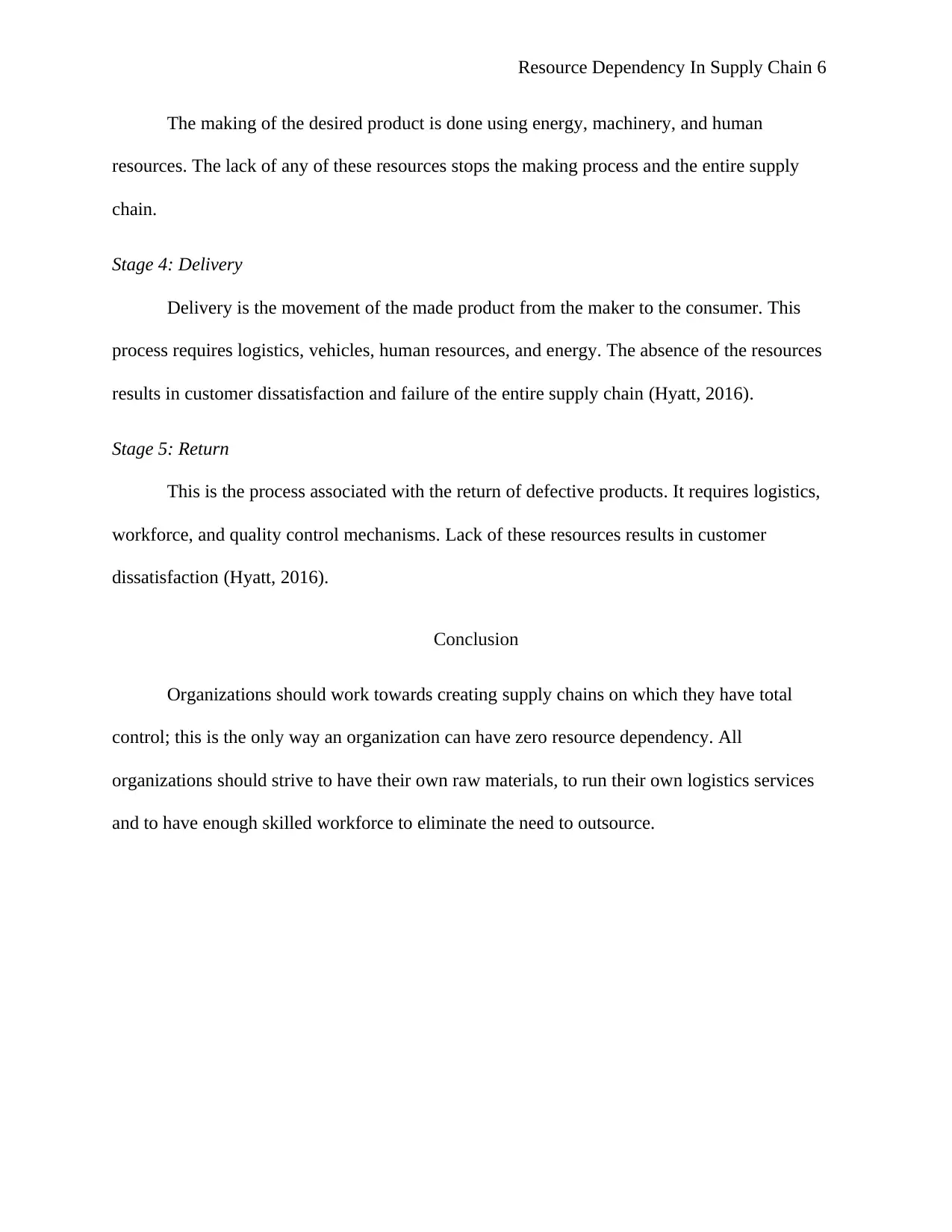
Resource Dependency In Supply Chain 6
The making of the desired product is done using energy, machinery, and human
resources. The lack of any of these resources stops the making process and the entire supply
chain.
Stage 4: Delivery
Delivery is the movement of the made product from the maker to the consumer. This
process requires logistics, vehicles, human resources, and energy. The absence of the resources
results in customer dissatisfaction and failure of the entire supply chain (Hyatt, 2016).
Stage 5: Return
This is the process associated with the return of defective products. It requires logistics,
workforce, and quality control mechanisms. Lack of these resources results in customer
dissatisfaction (Hyatt, 2016).
Conclusion
Organizations should work towards creating supply chains on which they have total
control; this is the only way an organization can have zero resource dependency. All
organizations should strive to have their own raw materials, to run their own logistics services
and to have enough skilled workforce to eliminate the need to outsource.
The making of the desired product is done using energy, machinery, and human
resources. The lack of any of these resources stops the making process and the entire supply
chain.
Stage 4: Delivery
Delivery is the movement of the made product from the maker to the consumer. This
process requires logistics, vehicles, human resources, and energy. The absence of the resources
results in customer dissatisfaction and failure of the entire supply chain (Hyatt, 2016).
Stage 5: Return
This is the process associated with the return of defective products. It requires logistics,
workforce, and quality control mechanisms. Lack of these resources results in customer
dissatisfaction (Hyatt, 2016).
Conclusion
Organizations should work towards creating supply chains on which they have total
control; this is the only way an organization can have zero resource dependency. All
organizations should strive to have their own raw materials, to run their own logistics services
and to have enough skilled workforce to eliminate the need to outsource.
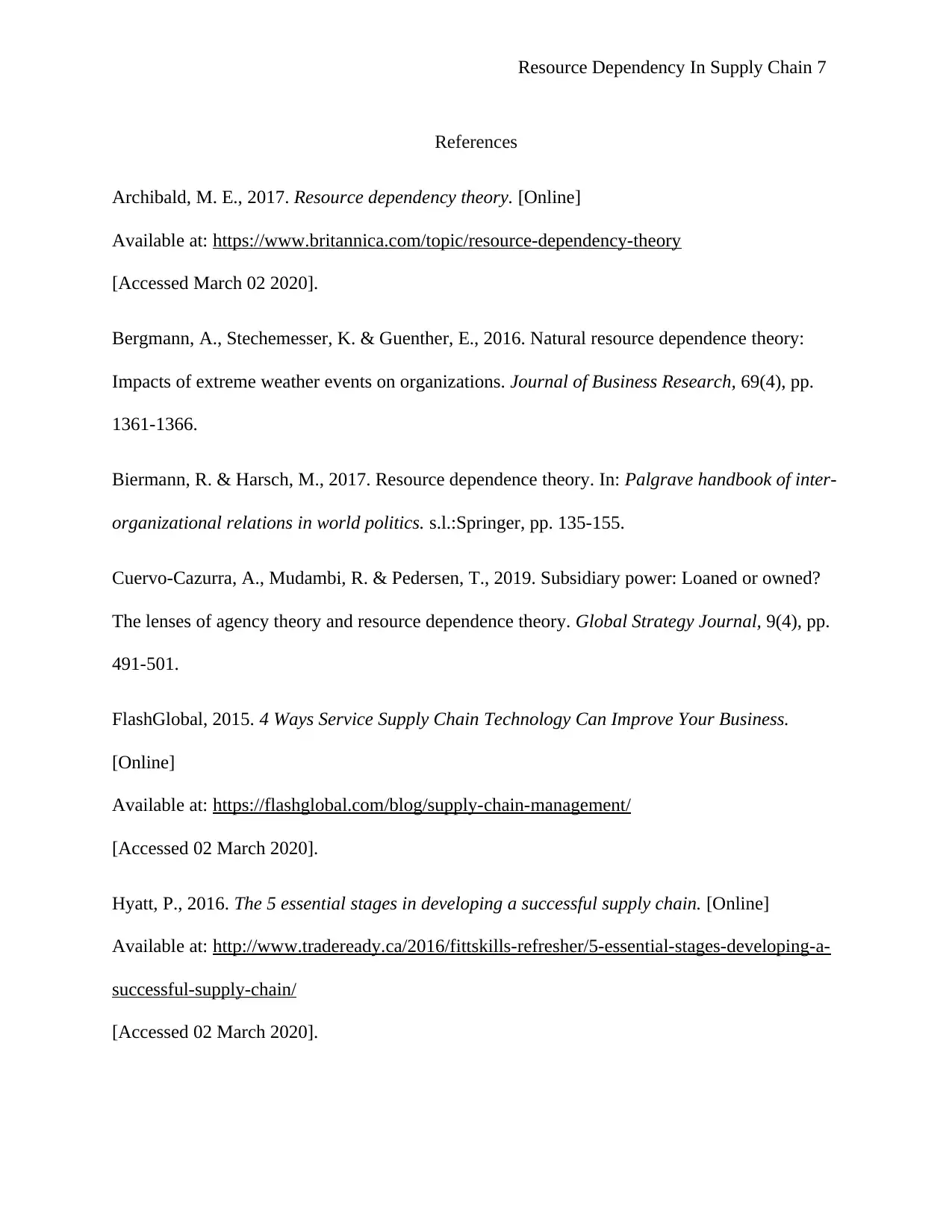
Resource Dependency In Supply Chain 7
References
Archibald, M. E., 2017. Resource dependency theory. [Online]
Available at: https://www.britannica.com/topic/resource-dependency-theory
[Accessed March 02 2020].
Bergmann, A., Stechemesser, K. & Guenther, E., 2016. Natural resource dependence theory:
Impacts of extreme weather events on organizations. Journal of Business Research, 69(4), pp.
1361-1366.
Biermann, R. & Harsch, M., 2017. Resource dependence theory. In: Palgrave handbook of inter-
organizational relations in world politics. s.l.:Springer, pp. 135-155.
Cuervo-Cazurra, A., Mudambi, R. & Pedersen, T., 2019. Subsidiary power: Loaned or owned?
The lenses of agency theory and resource dependence theory. Global Strategy Journal, 9(4), pp.
491-501.
FlashGlobal, 2015. 4 Ways Service Supply Chain Technology Can Improve Your Business.
[Online]
Available at: https://flashglobal.com/blog/supply-chain-management/
[Accessed 02 March 2020].
Hyatt, P., 2016. The 5 essential stages in developing a successful supply chain. [Online]
Available at: http://www.tradeready.ca/2016/fittskills-refresher/5-essential-stages-developing-a-
successful-supply-chain/
[Accessed 02 March 2020].
References
Archibald, M. E., 2017. Resource dependency theory. [Online]
Available at: https://www.britannica.com/topic/resource-dependency-theory
[Accessed March 02 2020].
Bergmann, A., Stechemesser, K. & Guenther, E., 2016. Natural resource dependence theory:
Impacts of extreme weather events on organizations. Journal of Business Research, 69(4), pp.
1361-1366.
Biermann, R. & Harsch, M., 2017. Resource dependence theory. In: Palgrave handbook of inter-
organizational relations in world politics. s.l.:Springer, pp. 135-155.
Cuervo-Cazurra, A., Mudambi, R. & Pedersen, T., 2019. Subsidiary power: Loaned or owned?
The lenses of agency theory and resource dependence theory. Global Strategy Journal, 9(4), pp.
491-501.
FlashGlobal, 2015. 4 Ways Service Supply Chain Technology Can Improve Your Business.
[Online]
Available at: https://flashglobal.com/blog/supply-chain-management/
[Accessed 02 March 2020].
Hyatt, P., 2016. The 5 essential stages in developing a successful supply chain. [Online]
Available at: http://www.tradeready.ca/2016/fittskills-refresher/5-essential-stages-developing-a-
successful-supply-chain/
[Accessed 02 March 2020].
Paraphrase This Document
Need a fresh take? Get an instant paraphrase of this document with our AI Paraphraser
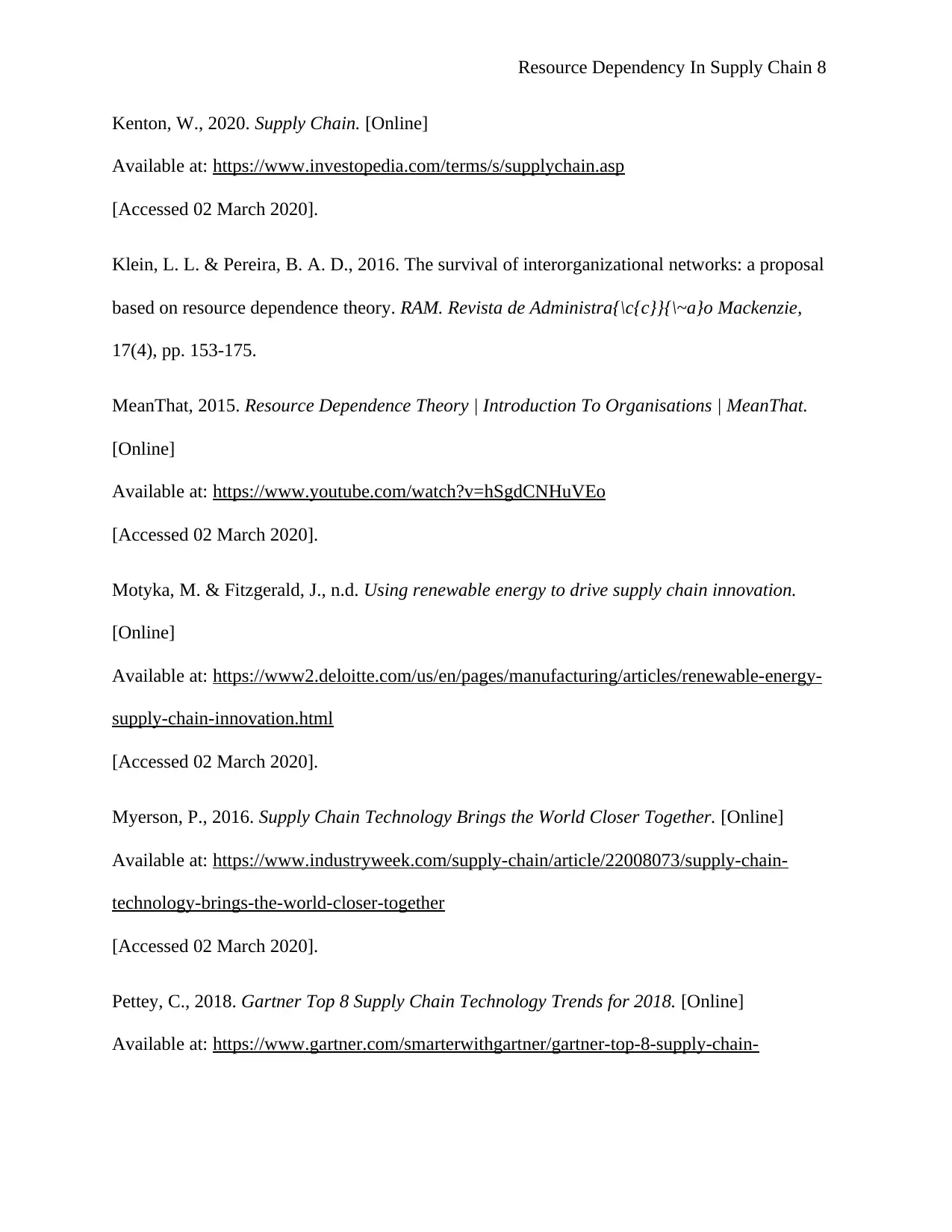
Resource Dependency In Supply Chain 8
Kenton, W., 2020. Supply Chain. [Online]
Available at: https://www.investopedia.com/terms/s/supplychain.asp
[Accessed 02 March 2020].
Klein, L. L. & Pereira, B. A. D., 2016. The survival of interorganizational networks: a proposal
based on resource dependence theory. RAM. Revista de Administra{\c{c}}{\~a}o Mackenzie,
17(4), pp. 153-175.
MeanThat, 2015. Resource Dependence Theory | Introduction To Organisations | MeanThat.
[Online]
Available at: https://www.youtube.com/watch?v=hSgdCNHuVEo
[Accessed 02 March 2020].
Motyka, M. & Fitzgerald, J., n.d. Using renewable energy to drive supply chain innovation.
[Online]
Available at: https://www2.deloitte.com/us/en/pages/manufacturing/articles/renewable-energy-
supply-chain-innovation.html
[Accessed 02 March 2020].
Myerson, P., 2016. Supply Chain Technology Brings the World Closer Together. [Online]
Available at: https://www.industryweek.com/supply-chain/article/22008073/supply-chain-
technology-brings-the-world-closer-together
[Accessed 02 March 2020].
Pettey, C., 2018. Gartner Top 8 Supply Chain Technology Trends for 2018. [Online]
Available at: https://www.gartner.com/smarterwithgartner/gartner-top-8-supply-chain-
Kenton, W., 2020. Supply Chain. [Online]
Available at: https://www.investopedia.com/terms/s/supplychain.asp
[Accessed 02 March 2020].
Klein, L. L. & Pereira, B. A. D., 2016. The survival of interorganizational networks: a proposal
based on resource dependence theory. RAM. Revista de Administra{\c{c}}{\~a}o Mackenzie,
17(4), pp. 153-175.
MeanThat, 2015. Resource Dependence Theory | Introduction To Organisations | MeanThat.
[Online]
Available at: https://www.youtube.com/watch?v=hSgdCNHuVEo
[Accessed 02 March 2020].
Motyka, M. & Fitzgerald, J., n.d. Using renewable energy to drive supply chain innovation.
[Online]
Available at: https://www2.deloitte.com/us/en/pages/manufacturing/articles/renewable-energy-
supply-chain-innovation.html
[Accessed 02 March 2020].
Myerson, P., 2016. Supply Chain Technology Brings the World Closer Together. [Online]
Available at: https://www.industryweek.com/supply-chain/article/22008073/supply-chain-
technology-brings-the-world-closer-together
[Accessed 02 March 2020].
Pettey, C., 2018. Gartner Top 8 Supply Chain Technology Trends for 2018. [Online]
Available at: https://www.gartner.com/smarterwithgartner/gartner-top-8-supply-chain-

Resource Dependency In Supply Chain 9
technology-trends-for-2018/
[Accessed 02 March 2020].
Prasad, S., Zakaria, R. & Altay, N., 2018. Big data in humanitarian supply chain networks: A
resource dependence perspective. Annals of Operations Research, 270(1-2), pp. 383-413.
Puzey, E., 2015. Technology’s Role in Improving the Supply Chain. [Online]
Available at:
http://www.supplychain247.com/article/technologys_role_in_improving_the_supply_chain
[Accessed 02 March 2020].
Schnittfeld, N. L. & Busch, T., 2016. Sustainability management within supply chains--a
resource dependence view. Business Strategy and the Environment, 25(5), pp. 337-354.
Walker, T., 2019. Amco Group awarded end to end tooling contract for supply to Morgan Motor
Company. [Online]
Available at: https://www.britishplastics.co.uk/News/amco-group-awarded-end-to-end-tooling-
contract-for-supply-to/
[Accessed 14 February 2020].
technology-trends-for-2018/
[Accessed 02 March 2020].
Prasad, S., Zakaria, R. & Altay, N., 2018. Big data in humanitarian supply chain networks: A
resource dependence perspective. Annals of Operations Research, 270(1-2), pp. 383-413.
Puzey, E., 2015. Technology’s Role in Improving the Supply Chain. [Online]
Available at:
http://www.supplychain247.com/article/technologys_role_in_improving_the_supply_chain
[Accessed 02 March 2020].
Schnittfeld, N. L. & Busch, T., 2016. Sustainability management within supply chains--a
resource dependence view. Business Strategy and the Environment, 25(5), pp. 337-354.
Walker, T., 2019. Amco Group awarded end to end tooling contract for supply to Morgan Motor
Company. [Online]
Available at: https://www.britishplastics.co.uk/News/amco-group-awarded-end-to-end-tooling-
contract-for-supply-to/
[Accessed 14 February 2020].
1 out of 9
Related Documents
Your All-in-One AI-Powered Toolkit for Academic Success.
+13062052269
info@desklib.com
Available 24*7 on WhatsApp / Email
![[object Object]](/_next/static/media/star-bottom.7253800d.svg)
Unlock your academic potential
© 2024 | Zucol Services PVT LTD | All rights reserved.





